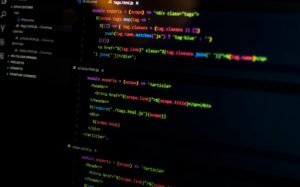Orca Generative Music
Orca generative music is a fascinating form of music creation that uses a unique programming language called Orca to produce music in a dynamic and evolving manner. Unlike traditional music composition, where notes and melodies are predetermined, Orca allows for the creation of complex patterns and algorithms that generate music in real-time. This innovative approach to music production has gained popularity among electronic music enthusiasts and experimental musicians.
Key Takeaways:
- Orca generative music relies on a programming language called Orca.
- It allows for the creation of complex patterns and algorithms.
- Orca generative music is popular among electronic music enthusiasts.
- It offers a unique and dynamic approach to music creation.
Orca is a visual programming language designed specifically for creating generative music. Developed by musician and programmer hundredrabbits, Orca uses a grid-based interface where each cell represents a musical note or event. By placing characters in different cells and connecting them with operators, users can create intricate patterns that interact with each other to produce evolving musical compositions. This unique approach to music creation allows for experimentation and the exploration of unconventional musical ideas.
*One interesting aspect of Orca is its ability to interface with other software and hardware devices, making it a versatile tool for music production and live performances.*
Orca generative music offers numerous benefits for musicians and music enthusiasts. It allows artists to break free from the limitations of traditional music composition and explore new sonic territories. The dynamic and evolving nature of generative music keeps the compositions fresh and ever-changing. Additionally, Orca’s visual interface provides an intuitive way to create complex musical structures, making it accessible to both seasoned musicians and beginners.
Table 1: Orca vs Traditional Music Composition
| Orca Generative Music | Traditional Music Composition |
|---|---|
| Dynamic and ever-changing compositions | Static compositions |
| Uses programming language and algorithms | Musical notation and theory |
| Allows for experimentation and unconventional ideas | Follows established musical conventions |
*With Orca, musicians can explore a wide range of musical possibilities and create unique compositions that continuously evolve.*
One notable feature of Orca generative music is its ability to interface with external software and hardware devices. This opens up opportunities for live performances where Orca can interact with synthesizers, drum machines, and other musical instruments in real-time. Musicians can create complex and dynamic performances that respond to their input and the audience’s reactions. This integration of Orca with other musical tools makes it a powerful addition to any performance setup.
Table 2: Orca Music’s Hardware Compatibility
| Hardware Device | Compatibility with Orca |
|---|---|
| Modular synthesizers | Compatible with CV/Gate inputs |
| Drum machines | Can trigger drum patterns and sequences |
| MIDI controllers | Supports MIDI input and output |
*The ability of Orca to interface with various hardware devices enhances its versatility and potential for live performances.*
In conclusion, Orca generative music provides a unique and dynamic approach to music creation. Its use of a programming language and complex algorithms allows musicians to create ever-changing compositions and experiment with unconventional ideas. With its compatibility with external software and hardware, Orca opens up new possibilities for live performances and interactive music experiences. Whether you’re an electronic music enthusiast or a seasoned musician, exploring Orca generative music can lead to exciting musical journeys and avant-garde sonic landscapes.
Table 3: Benefits of Orca Generative Music
| Benefits |
|---|
| Dynamic and evolving compositions |
| Experimentation and exploration of unconventional ideas |
| Intuitive visual interface |
| Compatibility with external software and hardware |

Common Misconceptions
Orca Generative Music
Orca Generative Music is a complex topic that often leads to various misconceptions. Let’s explore some of the common misunderstandings people may have:
Misconception 1: Orca Generative Music is just random noise
- Orca Generative Music is carefully composed and structured, using algorithms to generate specific musical patterns.
- Through complex programming, Orca creates intricate melodies and harmonies that go beyond random noise.
- While there is an element of randomness involved, it is controlled and guided by the user to create a cohesive and unique musical experience.
Misconception 2: Orca Generative Music is only for experimental artists
- Although Orca Generative Music is often associated with experimental genres, it can be used by any musician or artist looking to explore new creative possibilities.
- Artists from diverse musical backgrounds, including electronic, ambient, and even classical, can benefit from incorporating Orca into their compositions.
- By harnessing the power of generative algorithms, musicians can discover new musical ideas and expand their artistic horizons.
Misconception 3: Orca Generative Music lacks human creativity
- Orca Generative Music is created by humans who write and program the algorithms that generate the music.
- While the composition process may differ from traditional methods, it still involves human creativity and decision-making.
- The role of the artist is to create a framework and set parameters within which the generative algorithms can operate, allowing for the creation of unique and innovative musical works.
Misconception 4: Orca Generative Music is too complex for beginners
- Although getting started with Orca Generative Music may seem daunting, there are user-friendly interfaces and tutorials available to help beginners navigate the platform.
- Once the basic concepts are understood, beginners can gradually explore and experiment with different features to create their own music compositions.
- By starting with simple patterns and gradually increasing complexity, beginners can gradually master Orca Generative Music at their own pace.
Misconception 5: Orca Generative Music lacks emotion or human feeling
- While Orca Generative Music is generated by algorithms, it can still evoke emotions and convey human-like expressions.
- Through careful programming and design, Orca can produce music that is rich in emotions, ranging from calming and soothing to energetic and intense.
- The listener’s emotional response to the generated music relies on their subjective interpretation and personal connection with the auditory experience.

The Influence of Orca Whales on Generative Music
Orca whales, also known as killer whales, are widely recognized for their intelligence and complex vocalizations. In recent years, these majestic creatures have also become an unexpected source of inspiration for musicians and composers, particularly within the realm of generative music. Generative music refers to music that is created through a system of rules or algorithms, allowing for a continuous and evolving composition. This article explores the fascinating connection between orca whales and generative music, highlighting ten interesting aspects that shed light on their influence.
1. Genre Fusion: Orca Trance
Orca vocalizations exhibit an entrancing quality that has led to the emergence of a new genre known as “Orca Trance.” This genre combines the rhythmic and melodic patterns observed in orca vocalizations with electronic beats, creating a captivating and hypnotic musical experience.
2. Repetitive Rhythms
Through the study of orca vocalizations, researchers have discovered repetitive rhythmic patterns reminiscent of minimalist music. These patterns have been seamlessly integrated into generative music algorithms, providing a foundation for minimalist compositions that evolve over time.
3. Whalesong Symphonies
Generative music algorithms inspired by the ebb and flow of orca vocalizations have given rise to breathtaking whalesong symphonies. These compositions mimic the natural harmonies of orca communication, evoking a sense of awe and wonder in listeners.
4. Call and Response
Orca vocalizations often follow a call-and-response structure, with distinct phrases exchanged between individuals. This unique communication style has led to the creation of interactive generative music systems, where users can influence the composition by “responding” to the algorithm’s generated phrases.
5. Intensity Modulation
Orca vocalizations exhibit modulation in intensity, ranging from soft and gentle clicks to powerful and resonant calls. This modulation serves as a valuable tool in generative music, allowing for dynamically shifting intensities within compositions, creating a sense of drama and emotional depth.
6. Spatialization Techniques
Whales use echolocation to navigate and communicate in vast oceanic environments. Inspired by this sensory ability, musicians have incorporated spatialization techniques into generative music algorithms, creating immersive compositions that simulate the sensation of being surrounded by orca vocalizations.
7. Melodic Contours
Analyses of orca vocalizations have revealed intricate melodic contours, characterized by ascending and descending intervals. These melodic structures have been integrated into generative music systems, enabling the creation of emotionally evocative compositions that mirror the melodic complexity of orca communication.
8. Cross-Species Collaborations
Generative music has opened doors for innovative cross-species collaborations, bringing together musicians and orca whales in a shared musical exploration. By incorporating real-time orca vocalizations into generative music systems, these collaborations blur the boundaries between human and non-human artistic expression.
9. Whale-Sonifying Behavior
Researchers have ventured into the concept of “whale-sonification,” transforming various aspects of orca behavior, such as hunting strategies or social interactions, into generative music. This approach offers a unique insight into the sonic representation of complex ecological dynamics.
10. Conservation Advocacy
Through generative music inspired by orca whales, musicians have also found a way to raise awareness about the need for conservation efforts. By weaving reminders of the beauty and vulnerability of these creatures into their compositions, these artists strive to elicit a sense of responsibility and inspire action.
Conclusion
The mesmerizing vocalizations of orca whales have transcended their natural realm to become a powerful inspiration for generative music. By employing the diverse elements of orca communication, musicians and composers have pushed the boundaries of composition, resulting in hauntingly beautiful pieces that mirror the complexity and wonder of these marvelous creatures. Not only has this connection fostered new genres and musical techniques, but it has also become a conduit for conservation advocacy, ensuring that the captivating songs of orcas continue to resonate throughout generations to come.
Frequently Asked Questions
What is Orca Generative Music?
Orca Generative Music is a software tool that allows users to create music using a unique visual programming language. It uses a combination of symbols and patterns to control audio synthesis and sequencing, facilitating the creation of complex and algorithmic compositions.
How does Orca Generative Music work?
Orca Generative Music works by providing a visual interface where users can connect various modules together to create a musical composition. Each module represents a different function such as sound generation, sequencing, and effects processing. By connecting these modules with virtual cables, users can design intricate patterns and interactions to generate unique and evolving music.
What are the key features of Orca Generative Music?
Some key features of Orca Generative Music include a modular patching system, real-time audio synthesis, MIDI input/output support, algorithmic pattern generation, and the ability to create interactive compositions. It also offers extensive customization options allowing users to deeply explore the possibilities of generative music creation.
What skills do I need to use Orca Generative Music?
To use Orca Generative Music, no prior music production or programming experience is necessary. However, a basic understanding of musical concepts and an eagerness to experiment with sound and patterns would greatly enhance the creative process.
Can I use Orca Generative Music on any operating system?
Yes, Orca Generative Music is designed to be platform-independent. It can be used on Windows, macOS, and Linux operating systems, allowing a wide range of users to access and enjoy its creative potential.
Is Orca Generative Music suitable for live performances?
Yes, Orca Generative Music is suitable for live performances. Its real-time audio synthesis capabilities and interactive design allow musicians to create unique and evolving music on stage. It can be used alone or in conjunction with other MIDI-compatible software and hardware to create intricate and dynamic performances.
Can I export my compositions created with Orca Generative Music?
Yes, Orca Generative Music provides options to export your compositions in various audio formats, such as WAV or MIDI. This allows you to preserve and share your creations, whether it be for personal enjoyment or professional production purposes.
Are there any resources or tutorials available for learning Orca Generative Music?
Yes, there are several online resources and tutorials available to learn Orca Generative Music. These resources include documentation, video tutorials, and community forums where users can share their knowledge and experiences. These materials can assist users in understanding the software’s functionalities and help them explore its creative potential.
Can Orca Generative Music be integrated with other music production software?
Yes, Orca Generative Music can be integrated with other music production software. It supports MIDI input/output, allowing seamless communication with MIDI-compatible software and hardware. This integration expands the possibilities of utilizing Orca Generative Music in conjunction with other tools and workflows.
Can I use Orca Generative Music for commercial purposes?
Yes, Orca Generative Music can be used for commercial purposes. However, it is always recommended to review the specific licensing terms and conditions provided by the software’s developers to ensure compliance with any usage restrictions or requirements.




